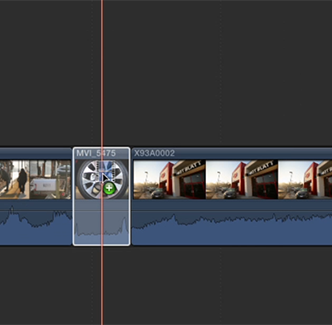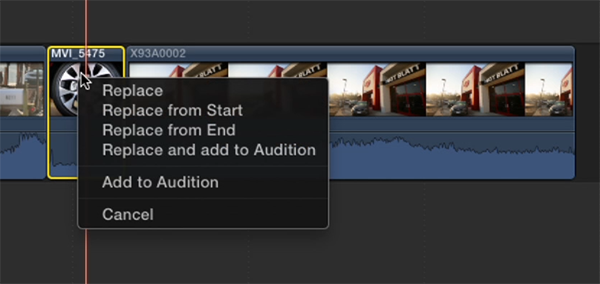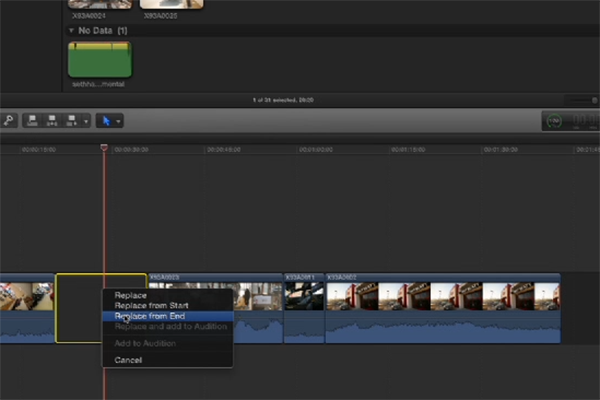Tutorial: Advanced Editing Techniques in Apple FCP X
This tutorial explores advanced editing techniques in FCP X including back-timing your edits, replacing edits and auditioning, top-and-tail editing, extend edits, trim-to-selection edits, keyboard trimming, and the Precision Editor.
Replace Edits
Next up is we’ll look at the replace edit and auditioning. Several times in editing, you’re going to find a shot that you don’t want, and would rather replace with something else. Of course, you could simply highlight it, delete it, find your replacement shot, and insert it. In FCP X you can do that with a single step called a replace edit. So we're just going to undo that.
In the car dealership video used in these tutorials, let’s say we have shot of a wheel, and we don't want it anymore. We want to replace it with a shot of a car interior.
So we can grab that shot, drag it down, and soon as it overlaps the shot in the timeine, you can see in Figure 5 (below) that it becomes a lighter shade. That’s when you know you're in the right position. You’ll also see a green button with a plus sign--another indication that you’re in the right spot.

Figure 5. Dragging down one clip to replace another in the Timeline
When you’ve got your clip in the right place, let go of the mouse button. A dialog box appears offering several choices (Figure 6, below).

Figure 6. The Replace Edit dialog
The first option, Replace, is just what it sounds like: a simple replace. It's not going to make adjustments with regard for length. So if the shot that you're bringing in is longer, it's going to make your timeline longer. If your shot is shorter, it's going to make your timeline shorter. In this case, our selection was longer, so it's actually going to make the timeline longer when it replaces it.
Now there are going to be instances where you’ve already timed your edit perfectly, like in a 30-second commercial spot, and you don't want to throw off the timing of your edit, but you still want to replace a particular shot. The good news is, in FCP X, you don't have to worry about making it an exact selection to the exact length or less to make sure it doesn't throw off your timing. You can go ahead and make your selection and drag it down. You already know the replacement clip is longer than the one currently in the timeline just by looking at it.
To replace a shorter clip with a longer one without making the timeline longer, choose either of the two next selection shown in Figure 6: Replace from Start or Replace from End. These options are very similar to a normal edit and a back-timed edit.
Replace from Start is going to bring that new clip in, and it's going to start the first frame of that new clip on the first frame of the clip that it's replacing. Replace from End, on the other hand, is going to back-time the replacement. In other words, it's going to take the clip that you selected, and have the last frame of that clip end on the last frame of the clip that you're replacing, and just trim the rest.
If we choose Replace from Start with a clip that’s longer than the clip it’s replacing, FCP X replaces the clip, but trims off the end of it. Likewise, if we choose Replace from End, it does the same thing, but it trims off the front of the clip.
So the replace edit is actually a very effective edit. There are times where I'll see a shot and know I don't want it. So rather than deleting and throwing off my timing, I can simply just do a Shift+Delete, which will leave a gap clip behind. So everything is still timed, and I know by looking at the gap clip, I need to go back later and fill that in. I can always grab a shot, drag it in, and do a replace edit. And if I choose Replace from End or Replace from Start, I know the replace edit won’t throw off my timing (Figure 7, below).

Figure 7. A Replace from End edit keeps the timing of the timeline intact.
Related Articles
Here's a look at two workflows for applying film grain to your footage in FCP X using cineLook (with and without Gorilla Grain), first with 4k footage shot with the Blackmagic Production Camera, and then with Cinestyle-flattened DSLR footage.
In our first tutorial on the recently released FCP 10.1, we look at the new Libraries feature, which enhances project and media organization and eases the adjustment for editors transitioning from FCP 7.
This tutorial on Apple Final Cut Pro X takes a closer look at color correction in the Inspector, exploring the Balance Color, Match Color, and Color Mask and Shape Mask features.
This tutorial on Apple Final Cut Pro X inspects the Video Inspector, a context-sensitive area of the FCP X interface that allows you to change settings of various filters and settings, and focuses on making basic but effective color adjustments.
In this video tutorial Glen Elliott of Cord3Films looks at FCP X's Timeline Index which provides innovative options for viewing, navigating, and searching your projects, including three different types of timeline markers and the ability to create a navigable To Do list of editing notes that's indispensable for collaborative workflows.
In this tutorial, Cord3Films' Glen Elliott demonstrates how to mix audio from multiple off-camera sources in a multicam edit in Apple Final Cut Pro X.
In part 2 of our series on multicam editing in Final Cut Pro X, Glen Elliott explains how you can accelerate and streamline the multicam-syncing process in Red Giant's PluralEyes 3.
Our Final Cut Pro X tutorial series continues with the first installment of a 3-part series on multicam editing in FCP X, addressing the basics like creating a multicam clip and cutting and switching audio and video using the Angle Editor.
Working with compound clips in FCP X is similar to nesting sequences in Final Cut Pro 7. Once you understand how it works, and how changes to compound clips can ripple across projects, it's a powerful feature that you'll find yourself using more and more.
In this tutorial, we'll look at several ways you can use connected storylines to enhance your FCP X edits and mix in cutaways and creative shots in a quick and efficient way.
The magnetic timeline is one of the major revolutionary changes in Apple Final Cut Pro X, and one of the areas editors struggle with when they're coming from track-based NLEs. In this tutorial we'll break it down and show you how to make it work for you.
In this first installment of our new tutorial series, Glen Elliott demystifies Final Cut Pro X, illustrates its core functions, and focuses on one of the most powerful new features for organizing, accelerating, and streamlining your edits: metadata keyword tagging.